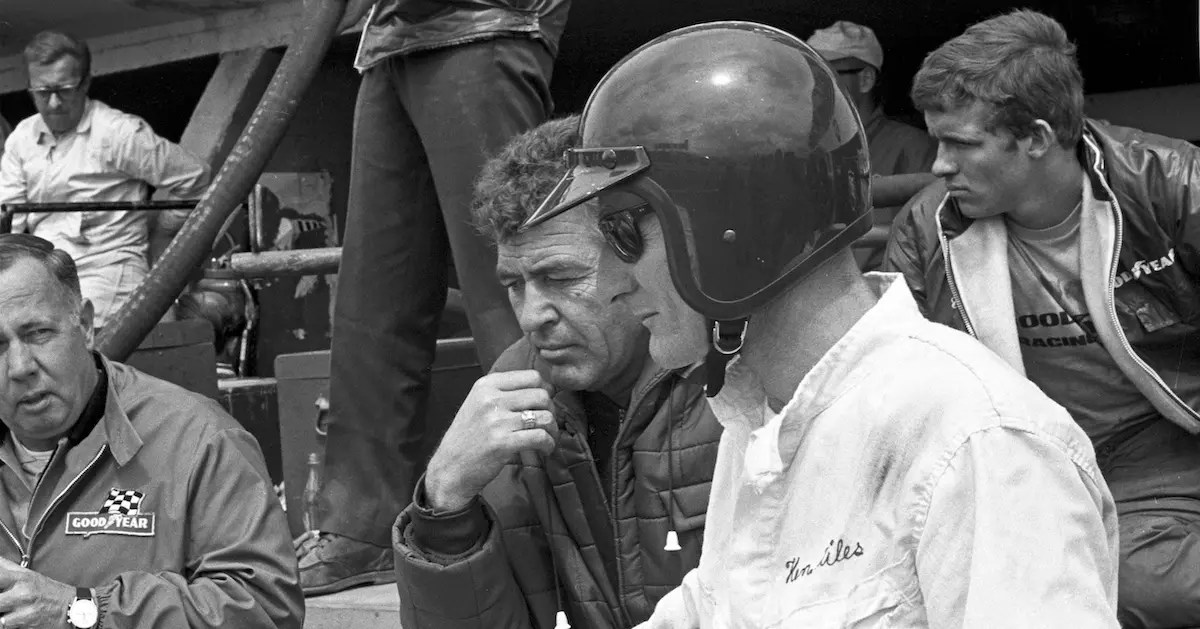What Happened To Ken Miles is a question that haunts the world of motorsports to this day. It refers to the mysterious circumstances surrounding the death of legendary British-American racing driver Ken Miles during the 1966 24 Hours of Le Mans.
Miles' death was a major turning point in the history of motor racing. As a skilled driver and engineer, he played a pivotal role in Ford's historic 1-2-3 finish at Le Mans in 1966. However, his untimely passing raised questions about safety standards in motor racing and the ethical responsibilities of racing teams.
This article will delve into the details of Ken Miles' final race, exploring the events leading up to his death and the aftermath that shaped the sport forever.
What Happened To Ken Miles
The circumstances surrounding Ken Miles' death during the 1966 24 Hours of Le Mans race are complex and multifaceted. To fully understand this tragic event, it is important to consider the following key aspects:
- Pre-race strategy: Ford's team orders and Miles' desire to win.
- Race conditions: The treacherous nature of the Le Mans circuit and the intense competition.
- Car performance: The mechanical issues experienced by Miles' Ford GT40 Mk II.
- Driver error: The possibility of human error contributing to the accident.
- Team communication: The lack of clear communication between Miles and the Ford team.
- Safety standards: The rudimentary safety measures in place during the 1966 Le Mans race.
- Aftermath: The impact of Miles' death on the racing community and the legacy of Ford's victory.
- Conspiracy theories: The persistent speculation surrounding the circumstances of Miles' death.
- Historical significance: The role of Miles' death in shaping the future of motor racing safety.
- Personal tragedy: The loss of a talented driver and beloved figure in the world of motorsports.
By examining these aspects in detail, we can gain a deeper understanding of what happened to Ken Miles and the profound impact his death had on the sport of motor racing.
Personal Details and Bio Data of Ken Miles
| Born: | November 1, 1918, in Sutton Coldfield, England |
| Died: | August 17, 1966, during the 24 Hours of Le Mans |
| Nationality: | British-American |
| Occupation: | Racing driver and engineer |
| Known for: | Playing a pivotal role in Ford's historic 1-2-3 finish at the 1966 24 Hours of Le Mans |
Pre-race strategy
Pre-race strategy played a significant role in the events leading up to Ken Miles' death in 1966. Ford's team orders and Miles' own desire to win created a complex and ultimately tragic situation.
- Team Orders
Ford's team manager, John Wyer, had given team orders to the drivers to maintain their positions and not race each other. This was intended to ensure a 1-2 finish for Ford, with Bruce McLaren and Chris Amon in the lead Ford GT40 Mk II and Miles and Denny Hulme in the second car. - Miles' Desire to Win
Miles was a fiercely competitive driver who had a burning desire to win. He was frustrated by the team orders and felt that he was capable of beating McLaren and Amon. This led him to push his car harder than he should have, taking risks that ultimately proved fatal. - Communication Breakdown
There was a communication breakdown between Miles and the Ford team during the race. Miles was not aware of the team orders and continued to push his car, believing that he was in contention for the win. This led to confusion and frustration, contributing to the tragic outcome. - Safety Concerns
The 1966 24 Hours of Le Mans was a particularly dangerous race, with several high-profile accidents. Miles' death highlighted the need for improved safety measures in motor racing. The race led to changes in safety regulations, including the introduction of the HANS device and stricter scrutineering of vehicles.
The combination of Ford's team orders, Miles' desire to win, communication breakdowns, and safety concerns all contributed to the tragic events of the 1966 24 Hours of Le Mans. Miles' death was a watershed moment in motor racing, leading to significant changes in safety regulations and a greater emphasis on driver safety.
Race conditions
Race conditions played a crucial role in the tragic events surrounding Ken Miles' death during the 1966 24 Hours of Le Mans. The treacherous nature of the Le Mans circuit and the intense competition among drivers created a dangerous and unforgiving environment.
- Circuit Design
The Le Mans circuit is one of the most challenging and dangerous in the world. It is a 13.6-mile track with long straights, fast corners, and unforgiving barriers. Drivers must maintain high speeds while navigating the circuit's many hazards. - Weather Conditions
The 24 Hours of Le Mans is held in June, when the weather can be unpredictable. Rain, fog, and darkness can make the track even more treacherous. Drivers must be prepared to adapt to changing conditions, which can affect their visibility and grip. - Car Performance
The cars competing in the 24 Hours of Le Mans are pushed to their limits. They are often running at high speeds for extended periods of time, which can lead to mechanical failures. Drivers must be aware of the potential risks and drive accordingly. - Driver Fatigue
The 24 Hours of Le Mans is a grueling race, both physically and mentally. Drivers must remain focused and alert for 24 hours straight. Fatigue can impair their judgment and reaction times, increasing the risk of accidents.
The combination of these race conditions created a dangerous environment for drivers in the 1966 24 Hours of Le Mans. Ken Miles' death was a tragic reminder of the risks involved in motor racing. In the years since, safety measures have been improved, but the Le Mans circuit remains one of the most challenging and unforgiving in the world.
Car performance
The mechanical issues experienced by Ken Miles' Ford GT40 Mk II played a critical role in his tragic accident at the 1966 24 Hours of Le Mans. Miles was leading the race when his car's engine blew, causing him to lose control and crash. The mechanical failure was a result of a combination of factors, including:
- Overheating: The Ford GT40 Mk II was known to have overheating issues, particularly under sustained high-speed running. Miles' car was pushed to the limit during the race, and the engine eventually overheated and failed.
- Defective components: There were also a number of defective components in Miles' car, including a faulty water pump and a weak crankshaft. These defects contributed to the engine failure and made the car more difficult to control.
The mechanical issues experienced by Miles' Ford GT40 Mk II were a major factor in his death. The car's engine failure caused him to lose control and crash, resulting in his untimely demise. This incident highlights the critical importance of car performance and reliability in motor racing.
Driver error
While mechanical failures and race conditions undoubtedly played significant roles in Ken Miles' fatal accident, the possibility of driver error cannot be overlooked. Human error is ever-present in motor racing and can manifest in various forms.
- Judgment Lapse
In the heat of competition, drivers may make errors in judgment, such as misjudging the speed or distance of other cars. Miles was known for his aggressive driving style, which may have contributed to his accident. - Physical Fatigue
Endurance races like Le Mans take a heavy toll on drivers, both physically and mentally. Fatigue can impair reaction times and decision-making abilities, increasing the risk of mistakes. - Mechanical Mishap
Driver error can also be caused by mechanical mishaps, such as a missed gear shift or a failure to engage the clutch properly. These mistakes can lead to a loss of control or a collision. - External Factors
External factors, such as weather conditions or debris on the track, can also contribute to driver error. Rain, fog, or a slippery track surface can make it difficult to control a car, while loose debris can cause a driver to lose traction.
While the exact cause of Miles' accident remains a subject of debate, it is clear that driver error could have been a contributing factor. This highlights the importance of driver training, experience, and situational awareness in motor racing.
Team communication
Team communication played a crucial role in the tragic events surrounding Ken Miles' death during the 1966 24 Hours of Le Mans. A lack of clear communication between Miles and the Ford team led to confusion and ultimately contributed to his fatal accident.
One key example of miscommunication occurred during the race when Miles was instructed by the team to slow down and maintain his position behind his teammate, Bruce McLaren. However, Miles, who was unaware of the team's strategy, continued to push hard, believing that he was in contention for the win. This led to confusion and frustration within the team, and ultimately contributed to Miles' decision to take risks that proved fatal.
The lack of clear communication between Miles and the Ford team highlights the critical importance of effective communication in motor racing. When drivers and teams are not on the same page, it can lead to misunderstandings, errors, and potentially catastrophic consequences.
In the years since Miles' death, there have been significant improvements in team communication in motor racing. Teams now use a variety of tools and technologies to ensure that drivers are fully aware of the team's strategy and any changes that need to be made during the race. This has helped to reduce the risk of accidents and improve the overall safety of the sport.
Safety standards
The 1966 24 Hours of Le Mans race was held in an era when safety standards in motor racing were still in their infancy. This lack of adequate safety measures contributed significantly to the tragic death of Ken Miles during the race. Here are some key aspects of the rudimentary safety measures in place at the time:
- Inadequate safety gear
Drivers in the 1966 Le Mans race wore minimal safety gear compared to today's standards. Their helmets, suits, and gloves offered limited protection in the event of a crash, increasing the risk of severe injuries.
- Lack of safety features in cars
The cars competing in the 1966 Le Mans race lacked many of the safety features that are now standard in race cars. These features, such as roll cages, energy-absorbing materials, and fire suppression systems, could have potentially saved Miles' life.
- Dangerous track conditions
The Le Mans circuit was not as safe as it is today. The track had several high-speed sections with limited run-off areas, making it extremely dangerous for drivers in the event of an accident.
- Inadequate medical facilities
The medical facilities at the 1966 Le Mans race were limited compared to today's standards. This lack of resources made it difficult to provide timely and effective medical attention to injured drivers, further increasing the risk of fatalities.
The combination of these rudimentary safety measures contributed to the tragic death of Ken Miles. In the years since, significant improvements have been made to safety standards in motor racing, helping to reduce the risk of serious injuries and fatalities. However, the legacy of Miles' death serves as a reminder of the importance of prioritizing safety in all forms of motorsport.
Aftermath
The aftermath of Ken Miles' death at the 1966 24 Hours of Le Mans had a profound impact on the racing community and the legacy of Ford's historic victory. Miles' death exposed the dangerous realities of motor racing and led to significant changes in safety regulations.
In the immediate aftermath of the accident, there was an outpouring of grief and shock from the racing community. Miles was a popular and respected driver, and his death was a major loss to the sport. Ford Motor Company was also deeply affected by Miles' death. The company had invested heavily in its Le Mans program, and Miles' death cast a shadow over their victory.
In the years since Miles' death, there have been many debates about his legacy. Some argue that he should be remembered as one of the greatest drivers of all time, while others believe that his death overshadows his achievements. However, there is no doubt that Miles' death had a significant impact on the sport of motor racing. His death led to important changes in safety regulations, and it serves as a reminder of the dangers that drivers face every time they get behind the wheel.
Conspiracy theories
The circumstances surrounding Ken Miles' death at the 1966 24 Hours of Le Mans have been the subject of much speculation and conspiracy theories over the years. Some believe that Miles was deliberately sabotaged by Ford Motor Company, while others believe that his death was the result of a tragic accident.
There is no definitive evidence to support any of these theories, but they persist because of the unanswered questions surrounding Miles' death. Why did his car crash? Why was he not given the chance to win the race? These questions continue to fuel speculation about what really happened on that fateful day.
The conspiracy theories surrounding Miles' death are a reminder that even in the most well-documented events, there is always room for doubt. They also serve as a warning about the dangers of believing everything we read or hear. When it comes to the death of Ken Miles, the truth may never be known.
Historical significance
Ken Miles' tragic death at the 1966 24 Hours of Le Mans was a watershed moment in motor racing safety. His death exposed the dangerous realities of the sport and led to significant changes in safety regulations.
- Improved safety features
In the wake of Miles' death, racing organizations and manufacturers implemented stricter safety standards for cars and tracks. This included the introduction of roll cages, energy-absorbing materials, and improved fire safety measures.
- Enhanced driver protection
Drivers began wearing more protective gear, including fire-resistant suits, helmets, and gloves. These measures helped to reduce the risk of serious injuries in the event of a crash.
- Revised track designs
Race tracks were redesigned to incorporate more safety features, such as wider run-off areas and improved medical facilities. These changes made it safer for drivers to compete at high speeds.
- Increased medical support
The availability of medical support at races was greatly improved. This included the deployment of more medical personnel and the establishment of dedicated medical centers at tracks.
The changes that were made in the wake of Miles' death have helped to make motor racing significantly safer. While there is still an inherent risk involved in the sport, the improvements that have been made have helped to reduce the number of serious injuries and fatalities.
Personal tragedy
The tragic death of Ken Miles at the 1966 24 Hours of Le Mans was a profound loss for the world of motorsports. Miles was a talented driver and beloved figure who had achieved great success in his career. His death was a reminder of the inherent dangers of the sport and the personal cost that can be paid in the pursuit of victory.
The loss of Miles had a significant impact on the motorsports community. He was a respected and admired driver, and his death was deeply felt by his fellow competitors, fans, and friends. Miles' death also sparked a renewed focus on safety in motorsports, leading to the implementation of stricter safety regulations and the development of new safety technologies.
The personal tragedy of Ken Miles' death serves as a reminder of the importance of safety in all walks of life. It is a reminder that even the most talented and experienced individuals can be vulnerable to accidents and that we must always strive to create a safe environment for ourselves and others.
The exploration of "What Happened to Ken Miles" sheds light on the complex interplay of factors that culminated in his tragic death. Miles' relentless pursuit of victory, coupled with communication breakdowns within the Ford team and inadequate safety measures, created a perfect storm that led to his untimely demise.
The key takeaways from this article are threefold. Firstly, it highlights the critical role of safety in motorsports and the need for constant vigilance to mitigate risks. Secondly, it underscores the importance of clear communication and teamwork in high-stakes environments. Lastly, it serves as a poignant reminder of the personal tragedies that can befall even the most skilled and dedicated individuals in the pursuit of their passions.
Aaron De Mey Dating Net: Your Guide To Finding True Connections
Paris St John Kristoff St: A Timeless Journey Through Valletta's Heart
Discover The Epitome Of Luxury Living At The Bentley Westville Klaarwater South



ncG1vNJzZmixn6O0rq2NrGpnraNixKa%2F02ZpZ5mdlsewusCwqmebn6J8uLTArWShmaClsq%2Bxw2arqGWbmrtuucilnKxmmKm6rQ%3D%3D